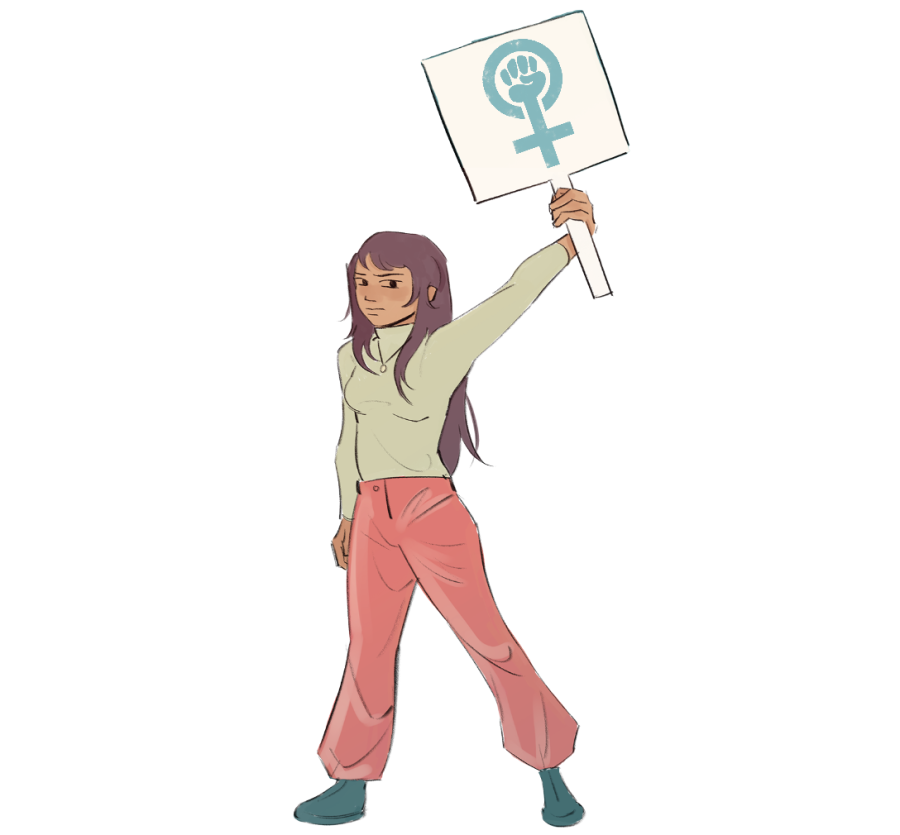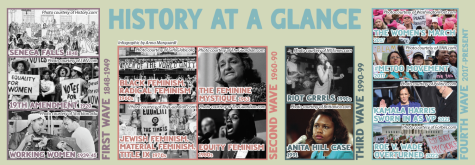FEMINISM; Students, staff reflect on movement
February 17, 2023
It is July 19, 1848 in Seneca Falls, New York, where women and men have gathered for the first time to fight for women’s suffrage, the right to vote. Abolitionists like Frederick Douglass and suffragettes such as Elizabeth Cady Stanton assembled to create a document parallel to the Declaration of Independence, called the Declaration of Sentiments, that included women, Tara Tate, Social Studies Teacher, described.
Susan B. Anthony made the first attempt to pass an amendment granting women votes in the 1880s, but it was not ratified until 14 years after Anthony’s death in 1920 when it became known as the 19th Amendment, Tate explained. As president of the National Woman Suffrage Association, Anthony was a great public speaker, politically strategic, and clever at understanding how to angle her fight with legislatures, Tate elaborated. Because of this, Anthony is often regarded as an icon and pioneer for the beginning of the women’s suffrage movement.
“[Anthony] was very strategic in regards to knowing where and how to fight, and that is a huge part of any movement, knowing where to lay the groundwork [and] what to ask for,” Tate said. “[Anthony’s story] is compelling; she was there from the beginning [of the movement].”
However, Anthony was not one of the most inclusive suffragettes regarding race; she prioritized white women’s suffrage over voting rights for all women, regardless of race, Tate explained.
“[Anthony] was pretty taken aback by the fact that Black men got the right to vote before women did,” Tate said. “She just wasn’t quite embracing [the idea of Black Americans voting].”
By the 1900s, however, much of the women’s rights movement began to include African American women, though there was still a large division with segregated parades and organizations, Tate explained.
“A lot of the women’s movement included African American women, but some did not,” Tate said. “There was a very big division in the women’s movement to include African American women, so some wanted them [and] some didn’t.”
Tate noted the brutality of the women’s suffrage movement and how it is often not recognized that these women suffered to achieve equal rights. Women went on hunger strikes, were arrested, and imprisoned, oftentimes with violent male prisoners in open barracks, Tate elaborated.
“I don’t think people know the risk that these women took to fight for the cause,” Tate said. “Even today, when I go to the ballot box and vote in every election, I think about those women and the sacrifices they made for me to have the right to vote.”
Senior Sara Khan explained that although white women were granted the right to vote in 1920, the fight for equal rights still continues today, especially for women of color. This is called intersectionality: being discriminated against for multiple reasons that overlap and create an interdependent system of disadvantage, Khan explained.
“[Women of color have been] historically paid way lower [wages],” Khan said. “[At the top there is] the white man dollar, [then] the white and Asian woman dollar, [with the] Black and Latino [dollars] lowest because of racism and sexism combined in the workforce and the hiring processes.”
Senior Al Tantalidou defined modern day feminism as the belief in equality for all sexes. They acknowledged the negative connotations encompassing the term, but emphasized that someone does not have to partake in movements or protests to call themself a feminist; instead, being a feminist starts with treating others with respect and being mindful of all perspectives.
“You don’t have to call yourself a feminist to have the principles that everyone should be equal,” Tantalidou said.
Tantalidou explained that patriarchal views can be harmful to men and women, and that feminism is beneficial to everyone.
“There is an openness for women to talk about their emotions and problems, whereas men are told to toughen up and be a man,” Tantalidou said. “[Men] are told the patriarchy is supposed to benefit them in the long run, and yet it creates emotionally immature, broken people.”
Khan recognized the importance of the current feminist movement and that, as a society and at South, students can improve in treating everyone equally. She elaborated on this stigma, specifically on common rhetoric towards women. Khan gave the example of Vice President Kamala Harris’ treatment.
“Look at Kamala Harris; she is not perfect,” Khan said. “But people can’t stop commenting about her hair or her laughter when [they] could actually be focusing on her policies.”
Khan believes a way South can be more supportive of women is by providing proper sanitary napkins; she has been advocating for this in Student Council for a long time, but nothing has been changed, despite her belief that the district has the resources to do so.
“Men, at least at [South, might] think those cardboard pads and tampons are okay–they’re not,” Khan said. “There [are] also people within our community that can’t afford the best products, so they come to school and that is where they get [feminine products].”
Although Tantalidou has noticed a lack of respect for women by their peers since transferring to South their sophomore year, they think that students are on the right track towards an entirely supportive environment.
“What the administration is currently doing, and what students’ attitudes are, need a lot of reshaping,” Tantalidou said. “I’m hopeful that the newer generations that come into [South] are going to do a better job.”
Oppositely, Tate feels as though South’s history curriculum does a good job of including feminist history in lessons. Whether through offered electives or required courses, Tate applauds the department’s willingness to celebrate diversity, despite her acknowledgement that there is always room to improve.
“[South’s history] classes do a great job of incorporating the story of women and the struggles they face,” Tate said. “But, there is always work to do, no matter [what].”




